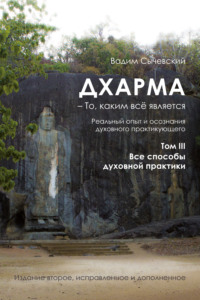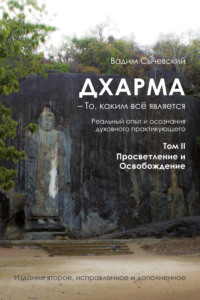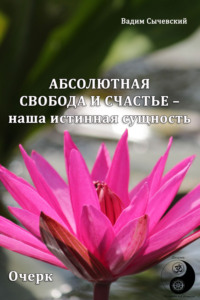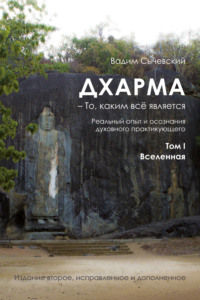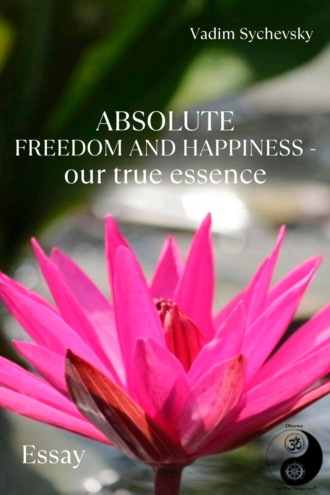
Полная версия
Absolute freedom and happiness – our true essence

Vadim Sychevskiy
Absolute freedom and happiness – our true essence. Essay

Translated from Russian by Nikolai Gnezdilov
All rights reserved. For free distribution only. When copying the materials presented in this Essay, a link to the original is obligatory.

© Sychevskiy V.V., 2024
© Aegitas Publishing House, 2024
Introduction
We are all spiritual beings. There is no doubt about that. The essence of a spiritual being is most often named consciousness. The limitation of the ordinary worldview manifests itself in the fact that we view our consciousness as some kind of limit or endpoint. In other words, we think that our consciousness is who we are. However, the True Dharma, or the Teaching that points us to the true reality, says that our true essence is the True «Self», which transcends consciousness and is the source of its arising. In Buddhism and Yoga, the True «Self» is described as the state of complete destruction of harmful passions, perfect cessation of suffering, and realization of true self-awareness, which is absolute freedom and happiness. In Sanskrit, The True «Self» is designated «Atman» and the state of the True «Self» is designated «Nirvana».
If we try to realize through spiritual practice this state that is hidden deep within us and is our true nature, our destiny will change greatly.
Knowledge of the True «Self», or self-awareness, is realized at the moment when our consciousness, which we usually think we are, returns to its original state of Calmness and Contemplation. The original state of our consciousness is also called Enlightenment.
There are a number of essential ways of spiritual practice that return our consciousness to its original enlightened state. However, the most important component of authentic spiritual practice is concentration. It is concentration that allows us to experience the cessation of the work of consciousness and for the first time to see our true nature, or Atman, a state of absolute, unconditioned freedom and happiness.
This state cannot be expressed with words, because the Atman is who we are in the true sense. The state of Atman is cognizable only empirically:
«The truth of self-realization [and reality itself] are not one and two. Through the power of this self-realization, [reality] can bestow others as much as itself; it is absolutely impartial, it lacks the ideas of 'this' and 'that,' it is like the ground from which everything grows. Reality itself has neither form nor non-form; like space, it is beyond [ordinary] knowledge and understanding; it is so elusively subtle that it cannot be expressed in words and letters. Why? Because it is beyond the realm of letters, words, speeches, chatter, discerning mind, questioning, and speculative reflection; at the same time it is beyond the comprehension of men in ignorance, beyond any evil deeds arising from evil intentions. For it is neither this nor that; it is beyond all rationality, it is formless and transcendent of all falsehood. It abides in the serenity of the uninhabited – that true abode of all saints.
O son of a noble family, the realm of self-realization, where all the wise dwell, is free from materiality; it is free from purity and free from darkness; free from apprehension and comprehension, free from the obscurity of confusion; it is resplendently pure, and its nature is indestructible» (Avatamsaka-sutra, «The Sutra of Forty Chapters», Chapter 31).
Therefore, as our spiritual concentration continues, a state of perfect peace of mind appears. Observing objects and phenomena in the outer world and our inner world, while in this state, we can make many discoveries. To our surprise and indescribable pure inner joy, we suddenly find that all things are completely different from what they appeared to us before. Discoveries of this kind can be called Enlightenment and many Enlightenments are many discoveries, it is the process of moving from the wrong view to the right view. The wrong view is based on attachment, anger, and delusion, whereas the right view is based on Calmness and Contemplation. Thus, it is after attachments, evil acts, and delusions are stopped that a calm and right view appears, by which we can see things as they really are. This pure vision is otherwise known as wisdom.
Then we continue our practice to fully master this state – to experience it not only in the actual but also in the deeper layers of our multilayered consciousness. When all levels of consciousness are completely stopped, we experience the state of Nirvana or Emancipation. Emancipation is the fixation of the state of Enlightenment.
If Emancipation is realized, then – in thought, speech, and action, whatever the movement of our thought, whatever the work of our speech, whatever the deed we perform – everything will be due to an increase in virtues and merit, an increase in understanding of the Laws of the Universe and an increase in Calmness and Contemplation. Finally, we will be able to attain great powers. This means that not only will we realize this state, which surpasses egoism, and the suffering it generates, and ultimately life and death, but we will also be able to help others to realize it.
Enlightenment is generally considered the absolute state that Prince Siddhartha Gautama realized in 589 B.C. when he became the Buddha (i.e., the «Awakened One» or «Enlightened One»). However, the Buddha state is the final stage of spiritual practice, the Final Enlightenment and Emancipation. This path begins with the first Enlightenment – with the cessation of the actual consciousness that we use in our daily lives, that we consider as ourselves above all else.
In the Original Buddhism (Theravada Buddhism) texts, the first Enlightenment corresponds to the first stage that the practitioner realizes – Entering the True Stream. The sutras say that such a person receives a fleeting vision of the goal – Nirvana.
The process of the first Enlightenment is described in the most detail in the texts of Zen Buddhism. In Zen, the first Enlightenment is referred to as «seeing one's true nature», or «Kensho» in Japanese. Zen Masters also emphasize that Kensho is the first real step toward Buddhahood:
«Anyone who calls himself a member of the Zen family must first of all attain Kensho, which is the realization of the Buddha's Way. It is a cruel fraud for anyone who calls himself a Zen follower but has not attained Kensho.
Wherever the Zen school has spread, a 'home abandoner' is anyone who has attained Kensho and left the home of birth and death, not one who has abandoned his home only to shave his head» (Hakuin Ekaku[1], «Wild Ivy»).
Many years ago, I experienced Kensho for the first time in this life. I will not undertake a logical explanation of the essence of this experience: logical or philosophical tricks and Kensho are opposite things. It is impossible to describe this primordial state of consciousness. In such cases, Masters of the past used to say, «It is as if a deaf-mute were to see a dream». In other words, one must have a personal experience of this state. «Personal experience» in this case means direct contact with the fact, without any intermediary.
At that moment, now in the distant year 1996, I was doing a walking practice not far from my house, and further…
I did not immediately realize what had happened, but I felt as if I had been waiting for this somehow very dear experience all my life, no – much longer. Where did this lightness in my body and mind come from? Whence this unconditioned happiness and calm joy!
The external sensations and the internal flow of thoughts had stopped, so it was as if the body and consciousness had disappeared. The face itself blurred into a natural, barely perceptible smile. External and internal objects remained, but the consciousness did not cling to them at all, so they once ceased to have any influence. The chaotic stream of thoughts no longer pressed on the mind as both dissolved into the majestic state of Calmness. All the darkness of things and their interactions with each other could fit on the tip of a fingernail – why do people look for value and meaning in this illusory jumble of cause and effect!? In this primordial state of consciousness, the division of the world into two poles completely disappears – dual thinking stops. If thoughts arise, they are seen as something external, crude, and completely meaningless.
Later I realized that only after the experience of Kensho does the real spiritual practice begin because Kensho gives an intuitive and very clear understanding of everything you come into contact with. Since one is no longer looking for oneself in objects and phenomena, one can see them rather than seeing the chaotic dual workings of one's consciousness. He who has seen (even if only in glimpses) reality is able to devote himself fully to the practice. He is unlikely to fail because for him there is nothing but spiritual practice. Hence, he is indeed capable of eventually attaining Emancipation[2].
I often remember the words spoken to me by a Zen Master to whom I described my experience:
– Your experience is true, I confirm it. Congratulations – you have glimpsed the Buddha! What are you going to do next?
– Continue, I replied.
– Continue what? – The experienced Master wouldn't let me off the hook.
– To continue my practice, because spiritual experience should be «made one's own»! – Somehow burst out of my mouth.
– Well, – he smiled at last, – the experience should be broadened. How long can you stay in this state of stopping the flow of the mind?
– In this state it is impossible to time it, because it also stops with the consciousness, but maybe 10–15 minutes…
– When you can stay in this state indefinitely, then it will be the Final Enlightenment, summarized the teacher.
«To expand my experience» – this is what I have been doing ever since, step by step expanding the realized then state of Calm and Contemplation.
If I were asked, «What was the most important, most memorable experience in your life?», I would say it was the Kensho experience. When asked what is the purpose of life? I would answer that, at the very least, in experiencing that experience.
Therefore, based on the True Dharma and my own experience of practice, I can say that the meaning and purpose of life is to return to one's true original state, which can be conventionally labeled as Atman (True «Self»), Nirvana, or Enlightenment and Emancipation.
In essence, they are synonyms. They are the same thing but from different angles. All these words point (they are pointing, not being: after all, they are just words) to something primordial, eternal, unchanging, absolute, and independent. The problem is that it is impossible to express THIS in any way. Because THIS is not some object, thing, or phenomenon external to us that has any properties, characteristics, or anything like that. It is somewhat ironic to say that no one can ever under any circumstances say: «This thing is my True „Self”. Look how beautiful and sparkling it is!». From this point of view, the «Self» does not exist. It is impossible to say anything about the Atman. It is an observer who is neither born nor dies, who is simply invisibly and naturally present. This is WE in the true sense. It is for this reason that I translate the term «Atman» as True „Self” with the pronoun «self» in quotation marks. In addition, when I use personal pronouns in an attempt to refer to the Atman, I make sure to italicize them, e.g., «The Five Aggregates are not self».
However, then, is there no point in studying the Dharma if its essence is inexpressible? Or to do spiritual practice just «for the sake of practice», since its purpose cannot be formulated or the formulation is so abstract? But the only true value is Nirvana, Enlightenment and Atman. They are the goal of true spiritual practice!
«The difference between mere scholarship or mere philosophizing, on the one hand, and self-realization, on the other, the difference between what is stated in words and what is transcendent to all verbal expressions, but must be personally experienced – this fundamental difference was strongly emphasized by the Buddha. His followers did not forget about this circumstance, trying not to lose sight of the desired state of self-realization» (D.T. Suzuki[3], «Essays on Zen Buddhism», part 2).
Atman, Nirvana, Enlightenment and Emancipation cannot be expressed, but we can try to find out what they are not. By following this method of elimination, we can probably come to at least a relative understanding.
In creating this essay, I am aiming to do just that – based on the texts of past Gurus and my own experience of spiritual practice, to show the reader the structure of our false «self». The very false «self» that binds us to the impermanent world of worldly desires and brings suffering. And having understood, at least in theory, what is not ourselves, we will be able to see the path leading to Enlightenment and Emancipation.
Chapter 1
Our False «Self»
Five Aggregates
(Illustration № 1, «Five Aggregates»)
I think it is not wrong to say that each of us has asked ourselves the question «who am I?» at least once in our lives. But have we ever found the answer? Am I this physical body? Am I my sensations, thoughts or emotions? Or am I something else? The teachings of the Five Aggregates bring us closer to understanding such questions. After all, the Five Aggregates are all that we have, all that we mistakenly believe we are, our true selves.
These five components of our false «self» are as follows:
1. Physical body – Pāli and Sanskrit: rūpa (literally: «form»).
2. Sensations (Feelings) – Pali and Sanskrit: vēdanā.
3. Perceptions – Pāli: saññā, Sanskrit: saṃjñā
4. Formed experience – Pāli: sankhāra, Sanskrit: saṃskāra.
5. Distinguishing consciousness – Pāli: viññāṇa, Sanskrit: vijñāna.
Unfortunately, neither mere enumeration nor arguments about what and how it should be translated from Pali and Sanskrit will bring us any closer to understanding these five components.
1. Physical body
The word «rupa» itself literally means «form». That is, all forms or, in normal modern language, objects, things, animate and inanimate objects that we can see or perceive, such as houses and trees, other people and cars driving down the street. Of course, all such external objects influence our lives and us. However, the greatest influence on us comes from the closest of all «forms» – our physical body. It is the one that imposes so many limitations on us and brings us not only fleeting joys but also inevitable suffering such as illness, old age, and death. Therefore, when we talk about the first of the Five Aggregates, we are referring first of all to our physical body.
So, each of us has a physical body, it serves as a carrier of our consciousness.
Two problems arise in the ordinary consciousness's perception of the physical body.
First, we are captured, attached to our body: «I am beautiful, slender, tall and statuesque». Or, conversely, «Why am I so ugly (ugly), low in stature, why do I have a bad figure!» and so on. Exactly the same wrong consideration we make about other people: «How beautiful she is, how slender he is, what wonderful muscles he has!» or, on the contrary: «How ugly, unattractive, fat he (she) is» and so on.
Secondly – complete identification of oneself with the physical body.
In order to change this wrong view, which leads to suffering, one should consider one's physical body impartially. There are two types of consideration of the physical body: Buddhist and yogic.
The first is to consider our physical body anatomically, just as we were taught in anatomy classes at school. There is the skin, deeper – the fat layer, then – muscles, tendons, and finally – the bones, the skeleton. Everywhere passes numerous blood vessels and nerves. There are internal organs belonging to different systems. Observing our bodies this way, we see that the physical body can be very beautiful and attractive outside, but things are quite different inside. Indeed, both the insides of our body are unpleasant to look at and smell. However, we recognize this anatomical fact rather than engage in a meditation of disgust. For example, if we consider our own or someone else's body beautiful, what exactly do we like: muscles, tendons, bones, or perhaps internal organs? Here we really begin to realize that the definition of «the body is beautiful» and attachment to the physical body looks very strange, if not foolish.
The yogic view is to consider the physical body as a collection of the Five Elements. The Earth Element is the solid components (e.g., bones), the Water Element is the liquid components (e.g., blood), the Fire Element is our body temperature, the Wind Element is breathing and energy movement and the Space Element is the voids and cavities in our body.
The meaning of observing both types is to realize that this physical body is not our true essence, but is simply a matter formed by gross substance, which controls various physiological processes without reference to ourselves. Our physical body is born, becomes sick, grows old, and dies. It restricts our freedom and binds us tightly to the gross material world. Besides, we cannot fully control our bodies – we cannot, for example, stop the aging process, and we cannot make our bodies immortal. That means that the physical body is not the True «Self». The body is the illusion that we experience with our senses. Therefore, as stated in the «Shiva Samhita»[4], «The only worthy use of this body is as a tool for attaining Nirvana».
2. Sensory organs and sensations
We have five external organs of sense located in our physical body: eyes, ears, nose, tongue, and touch receptors. Through them, as if through open doors, sensations come to us, that is, we see, hear, smell, taste, and feel touch, respectively. The sensations are the link between the external material world and our deeper consciousness.
We usually think of our sensations as pleasant, unpleasant, or neutral. But in reality, the sensation itself cannot be pleasant or unpleasant – it can be strong, weak, or absent. «Pleasant» or «unpleasant» is the dual workings of our consciousness based on our past experiences. Thus, the causes of our sufferings and joys are not to be found in the physical body and external sensations, but in our deeper Aggregates.
What do we see if we become calm, conscious observers of our sensations?
First, as long as our dual consciousness is active, there will be unpleasant, painful sensations. I think no one enjoys physical pain, disgusting odors, unpleasant sounds, and the like.
Secondly, of course, there will be pleasant sensations. But they are extremely impermanent and last, in fact, only for a moment. Further: if we want to get some pleasant sensation, and it is impossible, we suffer a great deal of dissatisfaction. How many times in your life have you thought or said, «I would give anything to have this»? Here we see that we are highly dependent on our sensations, we are unfree because of our attachment to pleasant sensations, and we suffer greatly when the pleasant sensations ends, or bores us, or we cannot get what we want.
Third, the more we seek the pleasures of sensations, the more we begin to feel pain and other unpleasant sensations. For example, as delicious and pleasurable for us was eating fresh gourmet food, exactly the same amount of tastelessness and unpleasantness will be experienced the day before yesterday's mediocre food. In other words, if there is a plus (i.e. pleasure), there is necessarily a minus (suffering), and the stronger the plus, the stronger the minus – they are equivalent. This principle applies not only to the sense organs and sensations but also to all experiences obtained through them. Thus, people who exhibit strong positive emotions when they experience pleasure, experience equally strong negative emotions when they encounter suffering.
Fourth, the previous example should lead to the idea that pleasant and unpleasant sensations can only exist at the same time. For example, if a person is anesthetized or given pain relief, both pain and pleasant sensations disappear. Or, for example, in order to not hear a loud unpleasant noise, a person plugs his ears with earplugs. The unpleasant noise disappears, but the pleasant or necessary sounds are no longer heard. In other words, if the joy that the senses bring increases, so also does the suffering. The sense organs are aggravated in two directions at the same time.
Fifth, we experience the joy or suffering of sensations exclusively because of the action of past experiences that are activated by our consciousness. Thus, sensations, as previously stated, can be strong, weak, or absent. «Pleasant» or «unpleasant» is the work of our dual consciousness.
By conducting this kind of consideration, we begin to realize that the senses and sensations are an illusion. The illusory nature of the senses is realized through breathing techniques. First, when the length of inhalations, exhalations, and breath-holding increases, the ability to perceive changes. People who have long inhalation, exhalation, and delay do not feel pain. But people with short breaths are sensitive to pain. This is not only true for pain. The same applies to the senses of sight, hearing, smell, and taste. To realize the existence of a consciousness that just «jumps» on these illusions of sensations, breathing techniques are done. Eventually, we reach a state where the senses and sensations come to a complete stop. In yoga terminology, this is called Pratyahara. When Pratyahara is realized, we are immersed from this material world into the Astral World (World of Forms[5]) in meditation.
Hence, our sense organs and the sensations that come through them are not our true nature. For example, if we are deprived of any sensation due to illness, say smell and taste due to a runny nose, we still continue to exist. If this is the case, then the True «Self» cannot be our sensations – they are illusory and we exist even if we lose all our senses and sensations.
3. Perceptions, images
The third of the Five Aggregates is Perceptions: information accumulated and stored in the form of images. All the information and experience that we accumulate every second through our actions remains in us. Perceptions, or Aggregate No.3, is our first internal storage unit, or reservoir, for the data we receive from the outside world. In Perceptions, these accumulated data are stored in the form of images.
The function of Perceptions is to generate (create) any image from the information we already have. For example, if you have never been to the Himalayas and I tell you about this place, you will be able to draw some pictures (images) in your imagination based on the information you have learned about the Himalayas so far, i.e. to imagine. Thus, the Aggregate itself is information in the form of images, and its function is to create images or figurative Perceptions.
To the function of Perceptions, we can also include such a thing as perception. The fact is that when we perceive any information from the external world, we automatically have a corresponding image, as in the example with the Himalayas just given. On the other hand, in our daily lives, we think about many things, but although we do not always put them into practice, each thought is nevertheless reflected in our Perceptions, i.e. it appears to us in the form of corresponding images.
Although Perceptions, unlike the body and sensations, are closer to our true essence, they are also not the True «Self».
For one thing, images bring us suffering. Of course, we can escape into the world of reverie for a while – immerse ourselves in pleasant memories or dreams in our imagination. However, how many horrifying pictures of the past, how many painful memories, and how many uncontrollable fears are stored in our images? Sometimes it even happens that a person who is haunted by horrifying memories of the past simply goes insane. Thus, if Perceptions cause suffering, they are not our essence – the True «Self» cannot harm or cause suffering to itself.





